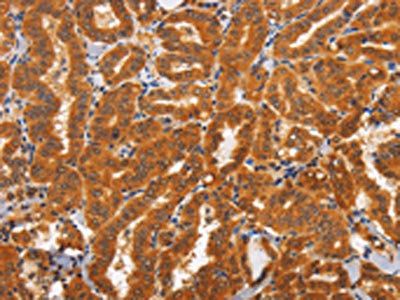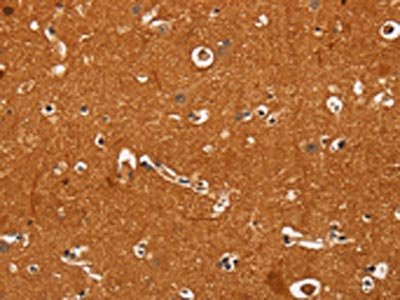TNFRSF8 Antibody
-
货号:CSB-PA912411
-
规格:¥1100
-
图片:
-
The image on the left is immunohistochemistry of paraffin-embedded Human thyroid cancer tissue using CSB-PA912411(TNFRSF8 Antibody) at dilution 1/60, on the right is treated with synthetic peptide. (Original magnification: ×200)
-
The image on the left is immunohistochemistry of paraffin-embedded Human brain tissue using CSB-PA912411(TNFRSF8 Antibody) at dilution 1/60, on the right is treated with synthetic peptide. (Original magnification: ×200)
-
-
其他:
产品详情
-
Uniprot No.:P28908
-
基因名:
-
别名:TNFRSF8; CD30; D1S166E; Tumor necrosis factor receptor superfamily member 8; CD30L receptor; Ki-1 antigen; Lymphocyte activation antigen CD30; CD antigen CD30
-
宿主:Rabbit
-
反应种属:Human
-
免疫原:Synthetic peptide of Human TNFRSF8
-
免疫原种属:Homo sapiens (Human)
-
标记方式:Non-conjugated
-
抗体亚型:IgG
-
纯化方式:Antigen affinity purification
-
浓度:It differs from different batches. Please contact us to confirm it.
-
保存缓冲液:-20°C, pH7.4 PBS, 0.05% NaN3, 40% Glycerol
-
产品提供形式:Liquid
-
应用范围:ELISA,IHC
-
推荐稀释比:
Application Recommended Dilution ELISA 1:2000-1:10000 IHC 1:100-1:300 -
Protocols:
-
储存条件:Upon receipt, store at -20°C or -80°C. Avoid repeated freeze.
-
货期:Basically, we can dispatch the products out in 1-3 working days after receiving your orders. Delivery time maybe differs from different purchasing way or location, please kindly consult your local distributors for specific delivery time.
相关产品
靶点详情
-
功能:Receptor for TNFSF8/CD30L. May play a role in the regulation of cellular growth and transformation of activated lymphoblasts. Regulates gene expression through activation of NF-kappa-B.
-
基因功能参考文献:
- Data suggest that CD4+ T cell-associated HIV-1 RNA is often highly enriched in cells expressing CD30; cells expressing this marker considerably contribute to total pool of transcriptionally active CD4+ lymphocytes in individuals on suppressive anti-retroviral drug therapy; CD30 may be a marker of residual, transcriptionally active HIV-1 infected cells in blood and in gut-associated lymphoid tissue. PMID: 29470552
- The stable elevation in classical Hodgkin lymphoma risk with elevated levels of sCD30 and IL6 across 4 or more years prior to diagnosis may also reflect a B-cell-stimulatory environment that promotes the genesis of these cancers. PMID: 28341757
- extranodal NK/T-cell lymphoma, nasal type(ENKTL) is the most common type of mature T-cell and NK-cell lymphoma diagnosed at our institution. CD30 is frequently expressed in ENKTL and represents a therapeutic target; however, it may not be a prognostic marker. PMID: 28486951
- This study suggests that in patients with CD30+ lymphoproliferative disorders, an aggressive clinical course cannot be defined by the presence of TP63 rearrangements, as was recently shown in systemic ALK negative anaplastic large cell lymphoma. PMID: 27146432
- Data suggest that Brentuximab Vedotin (SGN-35) damaged CD30 ligand (CD30L)-immune cells through CD30 extracellular vesicles (EVs). PMID: 27105521
- median FoxP3+ Treg count was higher in CD30+ than in CD30- posttransplant lymphoproliferative disorders, 3.0 vs 0 PMID: 29126177
- Variant histology is common in pediatric NLPHL, especially types C and E, which are associated with IgD expression. Type C variant histology and possibly type D are associated with decreased EFS, but neither IgD nor CD30 are adverse features. Variant histology may warrant increased surveillance, but did not affect overall survival. PMID: 28802087
- Expression of CD30 in patients with both DLBCL and other aggressive B-cell lymphomas and the absence of MYC oncogene-driven proliferation in the majority of these tumors suggests that brentuximab may be a particularly effective form of targeted therapy in the subset of patients with high CD30 expression. PMID: 27521276
- Prevalence of the CD30 (Ki-1) antigen in human solid tumors was summarized. PMID: 28427526
- Higher serum sCD30 levels were associated with an increased risk of bacterial infection after kidney transplantation. PMID: 28122147
- CD30 expression was detected in up to 25% of cases of diffuse large B-cell lymphoma and was more frequent in tumors without MYC rearrangement. CD30 expression was not associated with overall survival in R-EPOCH-treated de novo DLBCL patients. PMID: 27816715
- CD30 facilitates phosphorylation of heat shock factor 1, activates heat shock promoter element, and induces heat shock protein (HSP) 90. PMID: 27870927
- this study shows that polyclonal and allogeneic stimulation induced higher levels of CD30 transcripts in end-stage renal disease patients compared to control patients PMID: 26970513
- CD30 expression was not associated with prognosis in our cohort of de novoDLBCL, including in patients who received aggressive chemotherapy. CD30 expression and MYC rearrangement were mutually exclusive in de novoDLBCL. PMID: 26340843
- Case Report: CD30 positive lymphomatoid papulosis arising in association with cutaneous amyloidosis in a patient with multiple myeloma. PMID: 26981738
- The heterogeneity of CD30 expression in refractory or relapsed peripheral T-cell lymphoma patients indicates the likelihood for better response for patients with strong CD30 expression by tumor cells. PMID: 26703966
- CD30 may be useful as a prognostic marker in rituximab, cyclophosphamide, doxorubicin, vincristine, and prednisone (R-CHOP) treated DLBCLs, indicating favorable outcomes in a Chinese population. PMID: 26884853
- this review is focused on the role of CD30 receptor and p53 as novel targets for therapy in ALK+ ALCL, and also provides an update on their potential involvement in ALK+ ALCL pathogenesis PMID: 26709646
- Most angioimmunoblastic T-cell lymphoma and peripheral T-cell lymphoma-not otherwise specified express variable levels of CD30. PMID: 26574847
- Upregulated expression of CD30 is commonly found in sclerosing angiomatoid nodular transformation of the spleen. PMID: 26261484
- Our results demonstrated significantly elevated sCD30 levels in AS patients compared to healthy controls (HCs) with mean values of 32.0 +/- 12.2 and 24.9 +/- 8.0 ng/mL, (P(**) = 0.007), suggesting a p role of sCD30 in the pathogenesis of AS. PMID: 26273636
- With the introduction of the immunoconjugate brentuximab vedotin, the CD30 antigen has become an effectively targetable molecule. Therefore, we investigated the frequency and level of CD30 expression in post-transplant lymphoproliferative disorders. PMID: 25248878
- Data susggest that CD30 antigen may be useful as a prognostic factor and therapeutic target in extranodal natural killer/T-cell lymphoma (NKTCL). PMID: 25288491
- Data indicate that CD30 antigen downregulation and P-Glycoprotein (MDR1) upregulation are associated with drug resistance to brentuximab vedotin. PMID: 25840583
- Intralymphatic variant of ALCL and LyP may be explained, at least in part, by a particular lymphotropism of the neoplastic cells of cutaneous CD30 lymphoproliferative disorders. PMID: 26371781
- BAG-3 expression correlated with increased HSP70 expression in a subset of systemic T cell lymphoma cases co-expressing the CD30 antigen. PMID: 24492285
- These results show that high sCD30 levels are independent predictors of graft dysfunction PMID: 25698648
- Single threonine residue at position 61 in CD30v that is critical for TRAF2 interaction, NFkappaB activation, and downstream CD30-NFkappaB-dependent phenotypes in hESCs was identified. PMID: 25568342
- Case Report: describe a CD30+ lymphoproliferative rash exhibiting a predilection for recurrence on the same skin sites. PMID: 24733405
- case Report: primary cutaneous CD30+ anaplastic large cell lymphoma treated successfully with brentuximab vedotin. PMID: 24733422
- Elevated serum sCD30 is associated with increased risk of non-Hodgkin lymphoma. PMID: 25567136
- Case Report: suggest Sezary syndrome, CD30 anaplastic large-cell lymphoma, and mycosis fungioides are interrelated. PMID: 25548993
- levels of serum sCD30 tend to be higher in individuals with atopy. Improvement in lung function seems to be associated with a decrease in sCD30 in children with atopy and troublesome lung symptoms. PMID: 25492095
- occurs in a significant subset of angiosarcomas and epithelioid hemangioendotheliomas PMID: 24805132
- findings uncover the oncogenic role of the JUNB/CD30 axis and its potential as therapeutic target in ALK+ ALCL. PMID: 25145835
- Data indicate a chimeric fusion involving nucleophosmin NPM1 (5q35) and TYK2 kinase (19p13) that encodes an NPM1-TYK2 protein in cutaneous CD30 antigen-positve lymphoproliferative disorders. PMID: 25349176
- is expressed in a substantial proportion of DLBCL and CD30 immunohistochemistry may be a useful prognostic marker in R-CHOP treated GCB-DLBCL. PMID: 25135752
- The expression of CD30 by mastocytosis mast cells may influence the clinical phenotype and management of mastocytosis. (Review) PMID: 24745678
- a substantial subset of patients with T-ALL have lymphoblasts that express surface CD30. CD30 expression by T-lymphoblasts also appears to be up-regulated in patients who are treated with high-dose chemotherapy. PMID: 23937105
- Suggest intralymphatic cutaneous anaplastic large cell lymphoma/lymphomatoid papulosis are part of an expanding spectrum of CD30-positive lymphoproliferative disorders. PMID: 24805854
- higher serum levels in Ewing sarcoma patients with primary bone tumors PMID: 24375064
- diagnostic and prognostic value of CD30 expression in systemic mastocytosis as assessed by multiparameter flow cytometry PMID: 24111625
- this study highlights a novel SATB1-p21 axis that plays an important role in the disease progression of cutaneous CD30+LPDs, which provides novel molecular insights into this disease and possibly leads to new therapies in the future. PMID: 24747435
- serum concentration during pregnancy is not associated with pre-eclampsia and recurrent pregnancy loss PMID: 23268289
- CD30 expression on lymphomatous cells makes an attractive target for drug-conjugated antibody-directed therapies. PMID: 23716537
- CD30(+) peripheral T-cell lmyphomas differed significantly from CD30(-) samples. PMID: 23716562
- Post-transplant sCD30 serum levels, especially in conjunction with information regarding HLA class II antibodies and serum creatinine levels, provide valuable information regarding graft outcome PMID: 23928467
- Malignant Hodgkin and Reed-Sternberg cells release CD30 on the surface of extracellular vesicles facilitating CD30-CD30L interaction between cell types. PMID: 24659185
- High pretransplant levels of serum soluble CD30 can be a risk factor for kidney transplant rejection, and its high negative predictive value at various cutoffs make it useful to find candidates with a low risk of acute rejection after transplant. PMID: 23477385
- Soluble CD30 levels are significantly reduced in combination immunosuppression but are differentially affected by different immunosuppressant agents. PMID: 23503451
显示更多
收起更多
-
亚细胞定位:[Isoform 1]: Cell membrane; Single-pass type I membrane protein.; [Isoform 2]: Cytoplasm.
-
组织特异性:[Isoform 2]: Detected in alveolar macrophages (at protein level).
-
数据库链接:
HGNC: 11923
OMIM: 153243
KEGG: hsa:943
STRING: 9606.ENSP00000263932
UniGene: Hs.1314
Most popular with customers
-
-
YWHAB Recombinant Monoclonal Antibody
Applications: ELISA, WB, IF, FC
Species Reactivity: Human, Mouse, Rat
-
Phospho-YAP1 (S127) Recombinant Monoclonal Antibody
Applications: ELISA, WB, IHC
Species Reactivity: Human
-
-
-
-
-






















